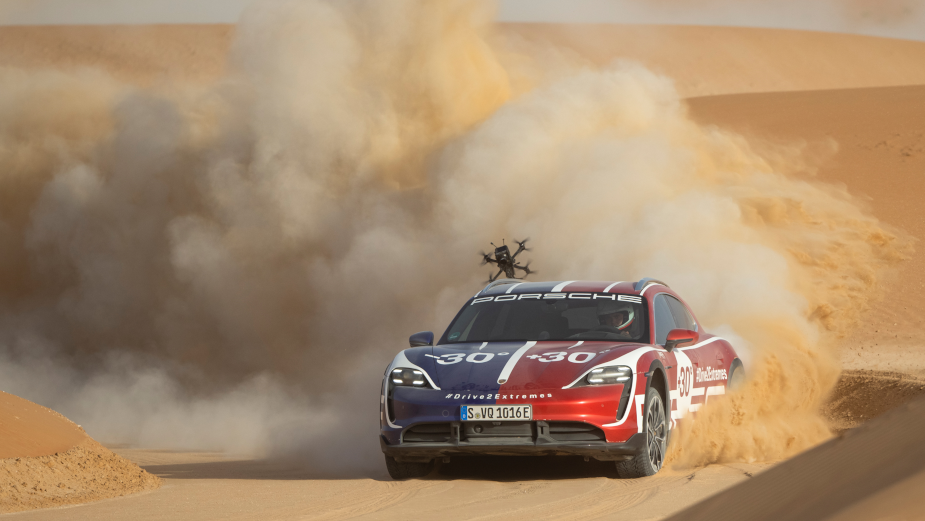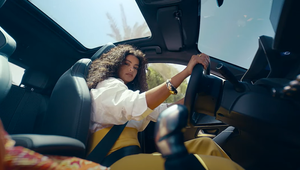
Two Worlds Take on One Track for Porsche's 'Drive2Extremes' Film

After launching its work 'Drive2Extremes' for Porsche Taycan, LBB sat down with Stoked and executive producer Rita El Hachem, director Nicholas Schrunck and FPV pilot, Johnny Schaer to go behind the scenes and found out more about how the project came to life.
Executive producer, Rita El Hachem
Q> When you saw the script, how did you break it down and find solutions?
Rita> When we receive courageous ideas that raise the bar, we get inspired as producers. First thought that came to our mind was that Nick would be the ideal director for this project. Having known him for many years now and seeing how he masterminds big, extreme and innovative films, we were certain that if anyone could pull this idea using only FPV drones it would be him. With the creative helm sorted out clearly in our minds, we started breaking down the locations.
The track in Levi in Finland was the main existing track and we needed to build an exact replica in the other extreme in the desert.
The desert location needed to be perfect with a beautiful background, a proper surface for driving, and logistically accessible.
In order to find the location that ticks all the boxes, we scouted Jordan and all over the UAE with a main focus on Liwa as it has the most picturesque dunes. Until we found this spot in Liwa and envisioned how gorgeous the track will be nestled among the small dunes. Nick our director was thrilled by the find.
We scouted this spot with Jukka Honkavuori the driver to make sure that the soil fits the purpose technically, then with the director to make sure it fits his vision artistically.
This spot allowed the car to move through those larger dunes, while also giving us the ability to create this stunning foreground. Ultimately, it was the hottest and most abrasive location we could find of the ones we considered, thanks to the limestone mixed with the sand, which made the surface work for driving.
The team from Porsche and Keko Dubai had a very clear vision of what they wanted. And above this they had the courage to go for something this daring in our complicated times.
Q> The drone shots are incredible – from a producer’s point of view, what are the challenges of working on such a dynamic, drone-heavy project?
Rita> Many challenges, the weather, the wind, the extreme temperatures and how you prepare for them.
The biggest challenge though was that you never see the shots as they happen, you only see them on playback. It needed courage and faith in the team.
Johnny is not only the world’s best FPV pilot but he is also an artist with high intelligence and a great eye and feeling for the space and the shots, and an innovator when it comes to drone cinematography.
Johnny had filmed with the Komodo previously, but on this project we were using the Freefly wave for the first time on an FVP, to achieve the slow motion shots. There was a bit of unexpectedness and learning in the process.
We needed to make sure that Johnny and his equipment are warm and functional in the -30 in Levi, so we prepared for that.
The desert however took its toll on the equipment, it was a carnage losing lenses, cameras and 30-40 propellers a day, so we were outsourcing props during the shoot from NYC and Europe to keep the stock going for the shoot.
Q> As I understand it, the spot was shot in Finland and Abu Dhabi – were you able to head to both locations yourself? And what are the different challenges presented by each location?
Rita> The day we were awarded this production, Finland announced that they will close their borders to international travellers. We decided to carry on and find a solution. We worked with Directors Guild, the servicing company in Finland to put a covid health and safety plan in place and they got the health authorities in Lapland to approve it and give us exception permits to enter.
Levi was brutally beautiful and cold, we needed to keep the batteries warm and Johnny warm so his thumbs could operate. We needed the wind to be down so we could fly the hot air balloon and do all the precision shots. But Since the track in Levi was a tested one we knew what to expect from the car and the drones.
Liwa however was a different story, the setting is gorgeous but the track was made specifically for this production, the car not tested on sand before. We could film only two hours in the early morning and two hours in the late afternoon, so our three day shoot became a seven day shoot that spanned all our rehearsal days. The commitment from everyone on the team was phenomenal. It all worked out very well.
The Abu Dhabi Film Commission supported us throughout the process to make it happen in Liwa on time and despite the covid restrictions and complications.
Q> What were the shoots themselves like – how long did they last and how many attempts did you get?
Rita> The shots needed to be precise so we can create a seamless edit merging the two worlds. And since the approach was to do it all in camera without resorting to CGI, we shot excessively to make sure we have the ideal moments from the car and the drone in the right location.
The coordination between Nick, Johnny and Jukka Honkavuori the driver was very clear and productive. And all three 'perfectionists' so repeating the shots till we nailed it was the norm on this shoot.
The through the window shot was the trickiest one, on the first day with no wind Johnny attempted to go through with a bigger quad, but the window size wasn’t ideal for that. Let’s say the first day of attempts was his rehearsal day, then on the second day he nailed it from the first attempt. You can imagine how stoked we all were!
Director Nicholas Schrunck
Q> When you saw the script, how did you break it down and what did you bring to it in the treatment?
Nick> So here’s the brief: you get the world's best drone pilot, world class precision driver, an ideal performance electric Porsche and two identical tracks in the most rugged and extreme environments.
But using only a drone, you must execute it continuously without using cuts.
It’s a gnarly idea. To have a chance of getting that right, there are three things that have to line up: locations, filming techniques, and themes. On this shoot, all of these were wrapped up in knotty logistics. We weren’t shooting a stage or anything in CG – these were real-life locations existing at the two extremes of temperature, and those practical realities had to steer creative.
First, we identified the different themes and elements. What was tricky, however, was needing two sets of elements – one in ice, one in desert – that matched but could logically exist in each of their respective environments. Huskies in Finland meant we needed desert dogs (called Salukies) in Abu Dhabi. Want to use camels? Guess we’d better find a herd of reindeer, too.
After sorting out locations, story elements, and themes, we added in the layer of face-melting cinematography that Johnny brings to the table. We also had to make sure it could all coexist in a high action, kinetic, and interactive world.
Further complicating this was the fact that most of the prep had to be done ahead of time, without any scouting of the tracks. So, we were working with these incredible elements of cinematography and location, but also with incredibly precise themes of story and elements. Oh, and we were doing it without using any cuts in the editing stage.
Q> How much have you worked with drones before? As a director what do you make of them?
Nick> I’ve worked with everything from helicopter setups in urban environments to small drones out in the backcountry. They really are an incredible tool. The FPV drones that Johnny is so well known for were a new tool for me, but we benefited from coming in without any preconceptions of what might work. A traditional aerial shot does not look good on FPV, and vice-versa. So having to take that baseline knowledge and reverse it, made me reconsider all the setups from scratch. FPV adds in a sense of immersion and engagement that other aerial shots do-not, but it’s not a licence to just shoot everything in a traditional FPV approach and our agreement was to do this differently.
Honestly, the dialog back and forth with Johnny – my challenging him to with shot ideas, and his refinement of them based on his experience – was one of the strongest creative building blocks of the shoot.
Q> It seems that the speed and complexity of the movements, the dynamic interaction with the cars and the slow motion elements make this a real challenge – how did you break that down and get your head around bringing all these aspects together? What was the most creatively interesting aspect of the project for you?
Nick> The dual tracks were the most creatively interesting aspect, being able to repeat the same ideas . In the pre-production stages, we knew of the beautiful location in Levi, Finland, and had specific GPS markings, tracks, and aerial photos.
However the car would churn up rocks that would be an instant drone crash if they connected, looks great but Johnny had to constantly dodge the roost of the car and the certain death that it brought.
The question, then, was where to build the desert track? It had to be perfect: a beautiful background, rugged appearance, proper surface for driving, and (most importantly for me) the ability to put it in an identical directional orientation to the track in Levi, so that we could have perfect continuity in the sunlight between the two.
To get to literally build a track from scratch in such a gorgeous and remote place was truly a dream come true.
Q> Why was it important to have that contrast between Abu Dhabi and Finland?
Nick> Because that contrast was the main story, featuring the electric vehicle as the single constant between those two extremes – and the Taycan Cross Turismo navigated both environments flawlessly. While the elements were different – it was beautiful to feature the same things in both. Having both camels and reindeers was a dream to shoot along with showing the roost of the car and the elements of rocks and ice flying at camera. While certainly they are foreign to each other, they are strikingly similar.
Q> How did you collaborate with the drone operator to build up the choreography? How fixed was that choreography? Or was there any room for improvisation?
Nick> In this whole process of travelling to the other side of the world and planning such a heavy logistical shoot, one element was a pleasant surprise: Johnny is literally my neighbour in Venice, CA, and yet we had never worked together previously. It helped us knock down prep in a covid limited world of travel.
On other shoots, you might have 3-5 cameras going at different times. With this being a single FPV drone camera project, there was intense pressure on Johnny to perform. My role, then, was really to create these moments, situations, and environments that allowed him to execute with the best light and driving conditions possible.
Not to discount all the high-tech aids we had (like GPS coordinate accurate tracks and high tech camera technology from RED and Freefly), but the most vital tool on this shoot was a laminated map with a dry erase pen. By coordinating the action between Johnny and the driver in this very lo-fi way, they could each drive their state-of-the-art machine – whether drone or Porsche – into the battle of the scene, with full confidence in what was expected of them in the shot.
Johnny is a gangster with flying, unparalleled really. He has his own twist on things and finds unexpected key moments, and sometimes I would toss in my own notes and ideas. As a result, the majority of the shoot was simply a back-and-forth dialog, as he flew, and we were both locked in on the shot in our FPV goggles.
Flying the drone through the window of a drifting car? Let’s just say that when he nailed that shot in Finland, they probably could’ve heard us cheering all the way back in the UAE.
Q> The slow motion aspects feel like something I’ve never seen before caught in live action. In fact, the first time I saw the teaser, I thought the clods of dirt flying past the drone must be CG! What’s the key to capturing these elements?
Nick> My background is in cinematography and, specifically, I’ve worked with slow motion cameras extensively in the sports world. I knew that fast-moving camera movement + slow-motion + particles of dirt and ice was a winning combination, and also that nobody had gotten it right yet. The difficulty is, you have to fly as fast and precise as possible, while being right in the danger zone behind the car and potentially getting smashed with all kinds of rock and debris.
I had the hunch that if anyone was going to go for this, it would be Johnny. We crashed a lot when executing these shots as we were literally shotgun blasting the drones with rocks and chunks of ice, but even the crashes in slow-motion were so epic. Once we got our rhythm down, we knew we were capturing something special.
Q> How did you approach the edit?
Nick> We approached the edit with two goals:
- No CG or fake composited shots of any kind, and
- No cuts, so everything needed to transition smoothly.
Technology has gotten to a point where so many things can be easily faked, and sometimes that’s OK for the story. In this film we did everything for real and shot obsessively to get the exact shot we needed.
For instance, shooting with the Saluki dogs in the desert: They are the fastest dog breed on the planet, and they also loved the drone and constantly followed it around after the takes. So, imagine chasing your dog around the park when he has no interest in obeying you – and now imagine doing that while a crew of 50 people watch (and wait) in the blazing heat.
To Johnny (the drone pilot) and Jukka’s (the driver) credit, they kept their cool and repeated the shots with perfect precision, while we got all the elements coordinated. Both were included with editing as Johnny has an eye for transitions and Jukka would help differentiate takes with driving nuance.
FPV Pilot, Johnny Schaer
Q> The way the drone interacts with the speeding cars is so striking – as a professional drone operator, what level of challenge did this project present to you?
Johnny> Flying alongside the Taycan was actually extremely fluid. The drone and car had very similar energy, which helped heighten the intensity and gave us an aggressive and exciting look. However, operating in the two extremes, especially in the cold of Finland, was a big challenge due to cold fingers.
It seems that the speed and complexity of the movements, the dynamic interaction with the cars and the slow motion elements make this a real challenge – how did you break that down and get your head around bringing all these aspects together?
Q> How did you collaborate with the director to build up/devise the choreography?
Johnny> A lot of the FPV is simply me reacting to what the car is doing. Nick the director was crucial in directing how the car should be driving, and setting up more specific shots such as those with the huskies, Saluki dogs, and balloon.
The slow motion aspects feel like something I’ve never seen before caught in live action. In fact, the first time I saw the teaser, I thought the clods of dirt flying past the drone must be CG! What’s the key to capturing these elements?
We shot the slow motion pieces in 4k 420fps, so combined with the brutal carnage of the sand, rocks, and ice shooting up into the face of the camera and drone, it made for some truly unreal one of a kind moments. The key here was to not be afraid, and to fly straight into the ‘danger zone’.










